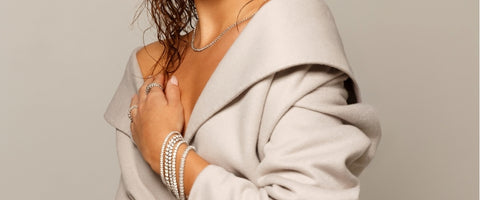Posted on July 21 2017

Buying a diamond is an exciting affair, but without the proper knowledge, it can appear to be quite adaunting task. Luckily, when dealing with a trusted and well-established jeweller, you are sure to be guided through the process comfortably, confidently, and with ease.
Today, let’s take a look into the process of diamond buying, and review some important factors that will determine the right stone for you.
Before jumping into the famed “4 C’s” of diamond buying, one should consider the shape of stone that they are looking for. As you may know, stones are available in countless shapes and sizes, each with their own distinctive appearance and radiant qualities. These include the classic round cut, princess cuts, marquise cuts, emerald cuts, and many more. Choosing a shape is largely based on personal tastes, but keep in mind that your desired shape will indeed affect the price of the stone.
Let’s discuss colour — a factor which plays a large role in determining the value of a particular stone. While diamonds occur naturally in a wide variety of colours, the most desirable stones are often described as colourless, when viewed under magnification, against a bright white background. Such stones would be given a D grading by gem certification organizations on a scale that goes from D to Z. As the grading of a stone nears to Z, a greater sense of warmth and a light yellow tone can be seen within the stone. Do note that lower grade, light yellow stones are not to be confused with fancy coloured yellow stones, which are a truly unique and stunning rarity of the gemological world.
Next, comes the second C of diamond buying, which of course is cut. This refers to just how well the stone has been processed from its raw, rough state, and as a result, how well light is able to both enter and exit the stone. In the case of an expertly processed “ideal” cut, light will both enter and exit the stone from the top, making for a radiant sparkling effect known as scintillation. Following ideal are excellent, very good, and good grade cuts.
After cut comes clarity. Clarity, as you’d expect, concerns the stone’s visual appearance, and more specifically, the internal imperfections that impact a stone’s value. These are commonly referred to as inclusions, and the frequency of their existence in a stone helps determines the grade which the stone receives. Naturally, flawless and internally flawless stones command the most, given the total absence of inclusions when viewed under 10x magnification. With that said, one should still consider viewing slightly and very slightly included stones as well, in that they can potentially offer better value.
Lastly, we have the final C of diamond buying, carat. Carat is a unit of mass used to measure the weight of both gemstones and pearls, that is roughly equivalent to 200 milligrams. While the carat weight is certainly an important factor in choosing a stone, it should be noted that carat weight does not determine a stone’s colour or scintillation, only the size and weight. With that said, it’s advised that you purchase the largest stone that your budget will allow, but be sure to give the other C’s equal consideration and thought.
With all of this mind, all that’s left to do is start the hunt, and find a perfect stone that’s right for you. Come in and visit us, we’ll gladly assist you with your purchase.




